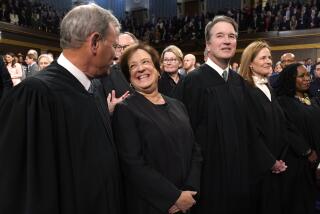A Ruling That Only Goldilocks Could Love
For 25 years, the country has struggled with the confusion over affirmative action left by the U.S. Supreme Court’s deeply divided Bakke decision. Monday, the court returned to this subject and left even greater confusion in its wake.
To the extent that the framers wanted the court to reflect society, they seem to have succeeded beyond their intentions: The nine justices appear just as divided as the rest of us.
Despite the victorious statements of pro-affirmative action groups, the two opinions -- one involving the University of Michigan law school and the other involving its undergraduate program -- should hardly be viewed as a cause for celebration.
The court did clearly affirm in its 5-4 decision in the law school case that diversity was a compelling state interest and that preference may be granted on the basis of race. But, at the same time, it completely rejected the undergraduate affirmative action plan, which gave a specific number of points to minorities on the basis of their race.
Of the two decisions, the undergraduate ruling may have a more lasting effect legally and politically. The decision by Chief Justice William Rehnquist was quite specific in rejecting a system that gave 20 points out of 150 for race -- a level of preference viewed as modest by some other programs. This line will now become the focus of the next generation of cases for opponents of affirmative action.
Conversely, Justice Sandra Day O’Connor’s decision in the law school case is so generally worded that it may be vulnerable to later reduction or outright rejection. The dissenting justices accuse O’Connor of brushing over past opinions and previously established standards to uphold the Michigan policy. Among these earlier sources are some of O’Connor’s own prior opinions that seem to contradict the result in this case.
In this decision, critics say O’Connor was somewhat cavalier in her application of the “strict scrutiny test,” which must be satisfied whenever the government uses a race-based classification. O’Connor, they say, accepted certain arguments of the law school uncritically. She is also criticized for not imposing a specific duration for the Michigan program or require that such programs be used only to remedy past discrimination. All of these points are contested by the four dissenting justices. Thus, much of this decision could evaporate with a seemingly innocuous tweaking of one of these elements by a new court majority, should one of the justices retire.
The dissenting justices may have sown the seeds for precisely such a later rematch. In the undergraduate case, these justices left open the question of the precise weight that can be given to race, while ruling that Michigan was clearly excessive in its program. This will trigger countless challenges using the rejected Michigan program as a benchmark.
The court is now in the position of a constitutional Goldilocks: What is too much, too little and just the right weight in an admissions program? The undergraduate case is an invitation for challenges and, as early as 2004, the court could have a new case and, more notably, a new majority.
Monday’s decisions will put affirmative action squarely on the agenda for the 2004 presidential election for two obvious reasons: The Bush administration opposed both admissions programs; the decision hangs by a single vote. With four justices expressing staunch opposition that is not likely to diminish with time, the next appointment to the court very likely will dictate the future of affirmative action. This puts the doctrines of affirmative action and abortion rights precariously on the 5-4 bubble.
Although Supreme Court nominees long have been used to rally conservative and liberal troops, the significance of the appointment issue is now quite real. A brief look at the majority in the law school case is hardly encouraging for pro-affirmative action advocates. Two of the five votes are considered ripe for retirement -- justices O’Connor and John Paul Stevens. Only one of the dissenting justices is expected to retire soon: Rehnquist.
For affirmative action, it has become a simple question of numbers, and the conservatives could ultimately prevail on the basis of actuarial rather constitutional realities. In a 5-4 world, the side with the youngest justices wins.
More to Read
Get the L.A. Times Politics newsletter
Deeply reported insights into legislation, politics and policy from Sacramento, Washington and beyond. In your inbox three times per week.
You may occasionally receive promotional content from the Los Angeles Times.










